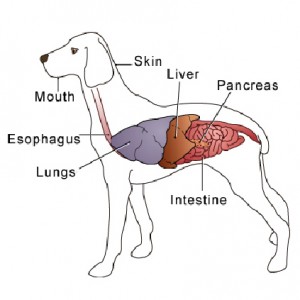Pancreatic Insufficiency
What is Pancreatic Insufficiency?
 The pancreas is an organ found near a dogs liver and intestine. The pancreas consists of two different types of pancreatic tissues which are mixed together throughout the organ. The pancreas plays a key role in many processes of the body including the production and release of digestive enzymes (produced by one type of pancreatic tissues) and hormones responsible for glucose regulation (produced by the other type of pancreatic tissues). Digestive enzymes, amylase, lipase, proteases and others) are released from the pancreas into the small intestine. The enzymes aide digestion. When these enzymes are damaged or lacking, the inadequate amount of good enzymes result in malnutrition, known as Excocine Pancreatic Insufficiency (EPI) despite the dog having a good appetite and good nutrition. EPI is also known as maldigestion of malabsorption.
The pancreas is an organ found near a dogs liver and intestine. The pancreas consists of two different types of pancreatic tissues which are mixed together throughout the organ. The pancreas plays a key role in many processes of the body including the production and release of digestive enzymes (produced by one type of pancreatic tissues) and hormones responsible for glucose regulation (produced by the other type of pancreatic tissues). Digestive enzymes, amylase, lipase, proteases and others) are released from the pancreas into the small intestine. The enzymes aide digestion. When these enzymes are damaged or lacking, the inadequate amount of good enzymes result in malnutrition, known as Excocine Pancreatic Insufficiency (EPI) despite the dog having a good appetite and good nutrition. EPI is also known as maldigestion of malabsorption.
In most cases it is only the tissues of the pancreas responsible for digestion that are destroyed. In a minority of cases the endocrine pancreas tissue, responsible for glucose regulation is also affected. If this is the case then the dog will develop diabetes, known as Endocrine Pancreatic Insufficiency.
EPI seems to have a genetic basis but is not congenital. It may develop at any age, although usually shows up before 4 years of age. The disease seems to be autosomal recessive, which means that carriers will appear normal. It is commonly found in German Shepherd Dogs and Rough Collies. Although Basenjis can be affected by this disease it is certainly not prolific.
How is Exocrine Pancreatic Insufficiency diagnosed and treated?
Diagnosis
Exocrine Pancreatic Insufficiency (EPI) is diagnosed by a blood test (TLI). The TLI test looks for trypsin-like enzymes in the bloodstream. An EPI affected dog will have almost no TLI in the bloodstream. The dog must be fasted before the blood is drawn but unlike the faecal test only one blood test is required to make a diagnosis. Another popular test is a faecal protease test. A stool sample is taken and tested for protein digesting enzymes. Fasting is not required for this test but three consecutive samples are required to obtain a consistent result due to the large variability in faecal enzyme activity. Another faecal test, tests for elastase. Only one sample is required. However, sometimes normal dogs will test negative for elastase. This means that EPI can be ruled out when the elastase test is positive but not confirmed when the elastase test is negative.
Treatment
Generally treatment for EPI involves supplementation of the dog with digestive enzymes, this is an effective treatment. Generally, treatment continues for the rest of the dogs life or symptoms are likely to return. A change in diet may also be a good idea. Generally, in EPI patients, a diet with foods that are low in fibre and fat are useful for dogs that have trouble gaining weight. EPI dogs commonly have a secondary condition - a bacterial overgrowth in their intestines. This usually results in a vitamin B-12 deficiency as the bacteria consume this vitamin before the animal can. A course of antibiotics usually corrects the overgrowth problem along with vitamin B-12 supplementation.

Leave a Reply
Want to join the discussion?Feel free to contribute!